by Matt Lollar | Feb 14, 2018
Register today for the 2018 Panhandle Fruit & Vegetable Conference! The Panhandle Fruit & Vegetable Conference is scheduled for February 19th & 20th. On the 19th we will go on an afternoon farm tour in Baldwin County, AL that will end with dinner (included) at Auburn University’s Gulf Coast Research and Extension Center in Fairhope. Educational sessions with guest speakers from University of Florida, Auburn University, and Texas A&M University will be held on February 20th where topics will include Citrus Production, Vegetable Production, Protected Ag Production, Marketing/Business, Food Safety, and Fruit & Nut Production. A full list of topics can be found here. Fifty dollars (plus $4.84 processing fee) covers the tour and dinner on the 19th and educational sessions, breakfast, and lunch on the 20th! The complete agenda is now available. Use your mouse or finger to “click” on the image below for full screen viewing.
Make sure to register by Wednesday, February 14th! – Registration Link
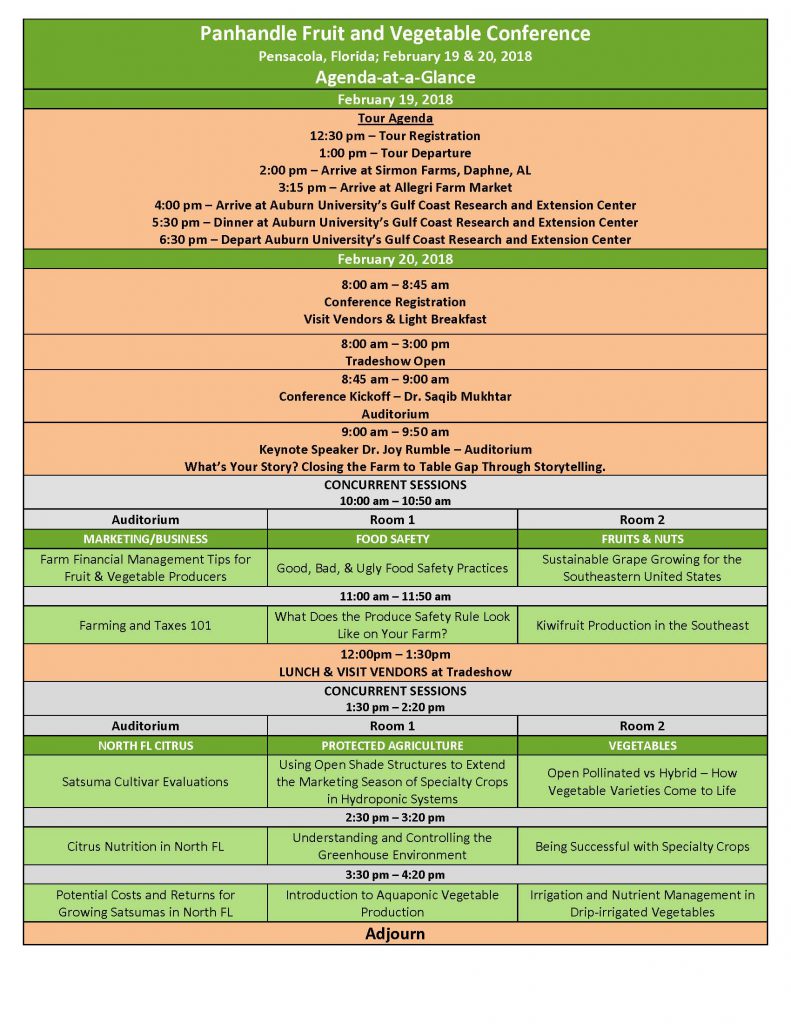
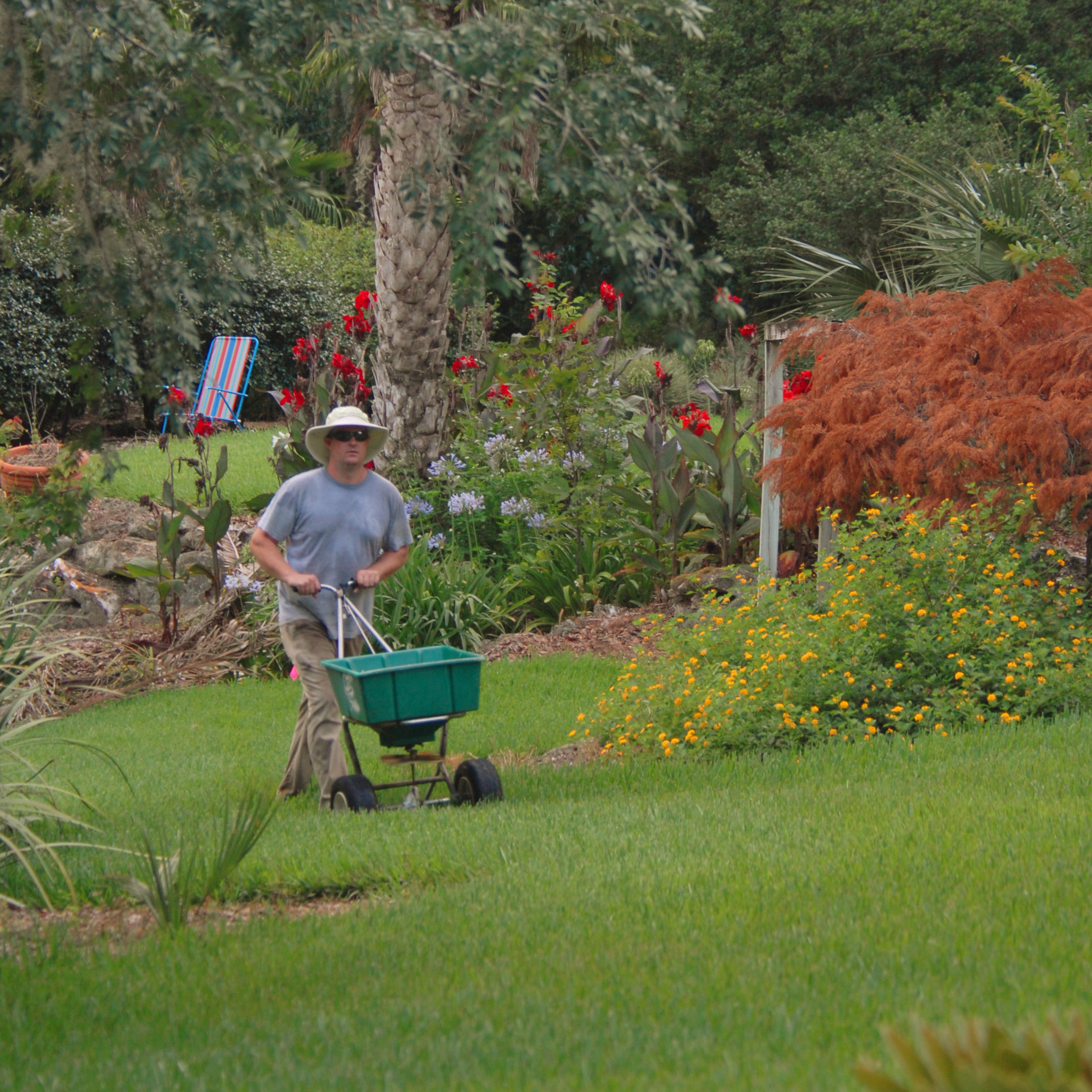
by Sheila Dunning | Jul 21, 2017
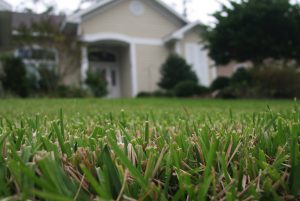
(UF/IFAS photo Thomas Wright)
Northwest Florida’s weather patterns can present challenges to maintaining a health lawn. Heavy rains promote fast growth and relentless sunshine causes lawns to fade. In the last 200 days we have received at least 68 days of rain. While the rest of Florida was experiencing record drought, the Panhandle was experiencing torrential downpours. With every drop of rain your spring fertilizer is being metabolized by the lawn, reducing how many nutrients remain in the soil. Even the best slow-release fertilizer will only last 3-4 months. The message is: “It’s time for more fertilizer.”
A healthy lawn is an important component of the urban landscape. Not only do lawns increase the value of a property, they also reduce soil erosion, filter stormwater runoff, cool the air, and reduce glare and noise. A healthy lawn effectively filters and traps sediment and pollutants that could otherwise contaminate surface waters and groundwater. Lawns require nutrients throughout the growing season to stay healthy. In Northwest Florida the growing season is typically April to October.
Proper fertilization consists of selecting the right type of fertilizer and applying it at the right time and in the right amount for maximum plant uptake. The type of fertilizer should be based on a soil test, available through UF/IFAS Extension. The timing of application and amount of fertilizer is dependent on the research-based recommendations for the grass species and the fertilizer analysis of the product being used.
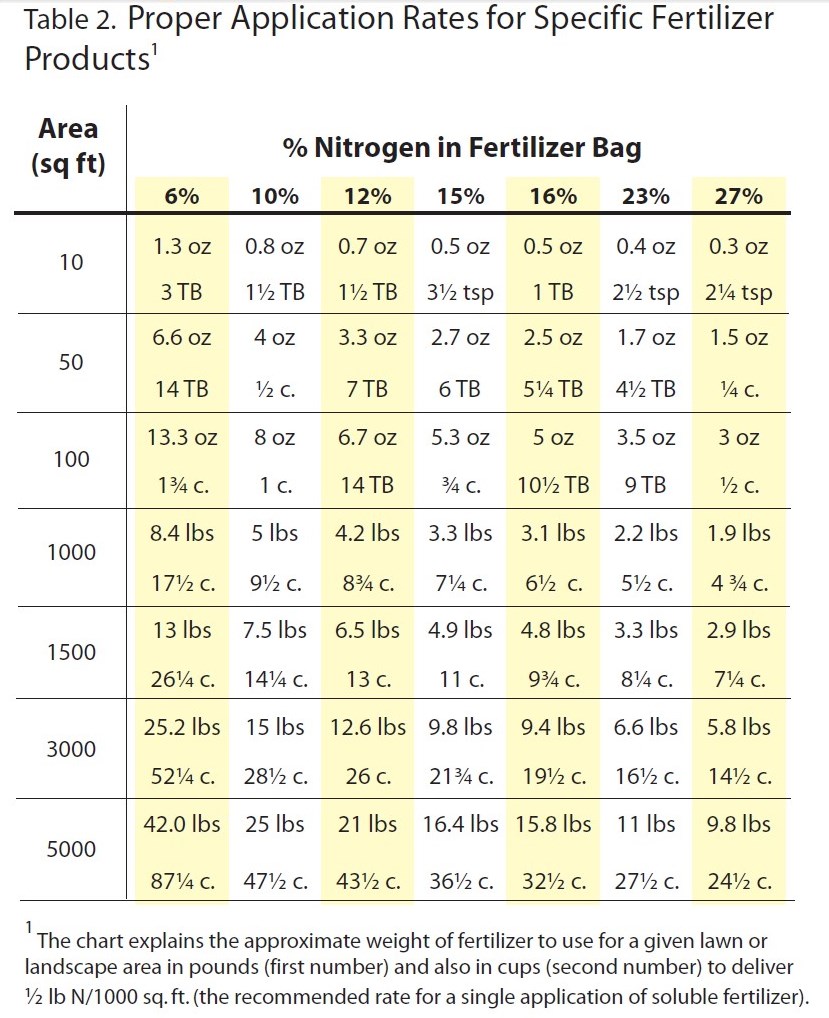
Chart excerpted from Florida Friendly Landscaping publication
Select only a fertilizer that states that the product is for use on residential turf. Do not use a fertilizer meant for flower or vegetable gardens on lawns. By Florida Administrative Code, Rule 5E-1.003, the Urban Turf Rule requires that the fertilizers being applied to residential lawns are labeled for the site and the application rates be followed. Typically, these products will contain both slow-release nitrogen and low or no phosphorus. Slow-release nitrogen will provide a longer-lasting response from the grass and reduces the potential for burning. For more information on the Urban Turf Rule go to: http://www.edis.ifas.ufl.edu/pdffiles/EP/EP35300.pdf.
With frequent rain the soil is also losing iron. Keep in mind that the green fading to yellow appearance in your lawn may be an iron deficiency. Before applying your summer fertilizer put out a liquid chelated iron. It will improve the health of the lawn while you are trying to find a dry day to fertilize. While it is necessary to water in fertilizer with ¼” of water to reduce burn potential and volatilization, never apply fertilizer when heavy rain is expected. The rainfall over ¼” can encourage runoff and/or leaching of that fertilizer, which can be costly and environmentally harmful.
by Daniel J. Leonard | May 18, 2017
If you’re like me, growing turfgrass is often more of a hassle than anything else. Regardless of the species you plant, none tolerates shade well and it can seem like there is a never-ending list of chores and expenses that accompany lawn grass: mowing (at least one a week during the summer), fertilizing, and constantly battling weeds, disease and bugs. Wouldn’t it be nice if there were an acceptable alternative, at least for the parts of the lawn that get a little less foot traffic or are shady? Turns out there is! Enter the wonderful world of perennial groundcovers!
Perennial groundcovers are just that, plants that are either evergreen or herbaceous (killed to the ground by frost, similar to turfgrass) and are aggressive enough to cover the ground quickly. Once established, these solid masses of stylish, easy to grow plants serve many of the same functions traditional turf lawns do without all the hassle: choke out weeds, provide pleasing aesthetics, reduce erosion and runoff, and provide a habitat for beneficial insects and wildlife.
The two most common turfgrass replacements found in Northwest Florida are Ornamental Perennial Peanut (Arachis glabra) and Asiatic Jasmine (Trachelospermum asiaticum); though a native species of Mimosa (Mimosa strigillosa) is gaining popularity also. All of these plants are outstanding groundcovers but each fills a specific niche in the landscape.

Perennial Peanut Lawn
Perennial Peanut is a beautiful, aggressive groundcover that spreads through underground rhizomes and possesses showy yellow flowers throughout the year; the show stops only in the coldest winters when the plant is burned back to the ground by frost. It thrives in sunny, well-drained soils, needs no supplemental irrigation once established and because it is a legume, requires little to no supplemental fertilizer. It even thrives in coastal areas that are subject to periodic salt spray! If Perennial Peanut ever begins to look a little unkempt, a quick mowing at 3-4” will enhance its appearance.

Asiatic Jasmine
Asiatic Jasmine is a superb, vining groundcover option for areas that receive partial to full shade, though it will tolerate full sun. This evergreen plant sports glossy dark green foliage and is extremely aggressive (lending itself to very rapid establishment). Though not as vigorous a climber as its more well-known cousin Confederate Jasmine (Trachelospermum jasminoides), Asiatic Jasmine will eventually begin to slowly climb trees and other structures once it is fully established; this habit is easily controlled with infrequent pruning. Do not look for flowers on this vining groundcover however, as it does not initiate the bloom cycle unless allowed to climb.

Sunshine Mimosa
For those that prefer an all-native landscape, Sunshine Mimosa (Mimosa strigillosa), also known as Sensitive Plant, is a fantastic groundcover option for full-sun situations. This herbaceous perennial is very striking in flower, sending up bright pink, fiber-optic like blooms about 6” above the foliage all summer long! Sunshine Mimosa, like Perennial Peanut, is a legume so fertility needs are very low. It is also exceptionally drought tolerant and thrives in the deepest sands. If there is a dry problem spot in your lawn that receives full sun, you can’t go wrong with this one!
As a rule, the method of establishing groundcovers as turfgrass replacements takes a bit longer than with laying sod, which allows for an “instant” lawn. With groundcovers, sprigging containerized plants is most common as this is how the majority of these species are grown in production nurseries. This process involves planting the containerized sprigs on a grid in the planting area no more than 12” apart. The sprigs may be planted closer together (8”-10”) if more rapid establishment is desired.
During the establishment phase, weed control is critical to ensure proper development of the groundcover. The first step to reduce competitive weeds is to clean the site thoroughly before planting with a non-selective herbicide such as Glyphosate. After planting, grassy weeds may be treated with one of the selective herbicides Fusilade, Poast, Select, or Prism. Unfortunately, there are not any chemical treatments for broadleaf weed control in ornamental groundcovers but these can be managed by mowing or hand pulling and will eventually be choked out by the groundcover.
If you are tired of the turfgrass life and want some relief, try an ornamental groundcover instead! They are low-maintenance, cost effective, and very attractive! Happy gardening and as always, contact your local UF/IFAS County Extension Office for more information about this topic!
by Julie McConnell | Feb 23, 2017
Regardless of what the tag says one size does not fit all. As with clothing, a piece will undoubtedly be too large for some and too small for others. Trying to go with a “one size fits all” approach to lawn care will lead to the same kind of frustration and disappointment as an ill-fitting garment.
All turfgrass is not created equal. Thus management of our various turf species requires different methods. It is common for a homeowner to be unaware of what type of turfgrass they have – it’s all grass after all – what difference does it make? Misidentification leads to problems because proper management for one type may be counterproductive to another type. In order to create a practical turf management plan, it is critical that the species of grass is properly identified.
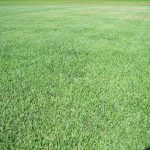
Although many grasses look similar it is important to know exactly what kind you have to maintain it properly. This photo shows Empire Zoysia. Photo credit: Julie McConnell, UF/IFAS
Why is it important to know the species of turf in a lawn?
Two of the most common mistakes extension agents observe is excessively low mowing height of St. Augustinegrass and over-fertilizing Centipedegrass. Both of these errors can reduce turfgrass vigor and decrease its tolerance to pest issues. Another potential maintenance pitfall is using a herbicide that is not labeled for use on a given type of turfgrass. Several popular herbicides available on the market can cause damage to St. Augustinegrass and/or Centipedegrass. Thus turf can be inadvertently killed by herbicides when they are applied to the wrong species.
Before a lawn maintenance plan is developed, be sure to know what type of grass is present and then follow UF/IFAS recommendations for proper care. If assistance is needed with identification, contact your local extension office.
To learn more about lawn care, visit this site or plan to attend “Caring for Your Florida Lawn” at the UF/IFAS Extension Bay County office on April 8th. For more details call 850-784-6105.

by Ray Bodrey | Aug 19, 2016
Being a gardener in the panhandle has its advantages. We’re able to grow a tremendous variety of vegetables on a year-round basis. However, in this climate, plant diseases, insects and weeds can often thrive. Usually, chemical measures are applied to thwart these pests. Some panhandle gardeners are now searching for techniques regarding a more natural form of gardening, known as organic. With fall garden planting just ahead, this may be an option for conventional vegetable gardeners looking for a challenge.

Vegetable Garden at UF/IFAS Extension Wakulla County. Photo credit: Ray Bodrey UF/IFAS.
So, what is organic gardening? Well, that really depends on who you ask. A broad definition is gardening without the use of synthesized fertilizers and industrial pesticides. Fair warning, “organic” does not translate into easier physical gardening methods. Laborious weeding and amending of soil are big parts of this gardening philosophy. This begs the question, why give up these proven industrial nutrient and pest control practices? Answer: organic gardening enthusiasts are extremely health conscious with the belief that vigorous outdoor activity coupled with food free of industrial chemicals will lead to better nutrition and health.
As stated earlier, the main difference between conventional and organic gardening is the methods used in fertilization and pest control. In either gardening style, be sure to select a garden plot with well-drained soil, as this is key for any vegetable crop. Soil preparation is the most important step in the process. To have a successful organic operation, the garden will require abundant quantities of organic material, usually in the form of animal manures and compost or mixed organic fertilizer. These materials will ensure water and nutrient holding capacity. Organic matter also supports microbiological activity in the soil. This contributes additional nutrients for plant uptake. Organic fertilizers and conditioners work very slowly. The vegetable garden soil will need to be mixed and prepped at least three weeks ahead of planting.
Effective organic pest management begins with observing the correct planting times, selection of the proper plant variety and water scheduling. Selecting vegetable varieties with pest resistant characteristics should be considered. Crop rotation is also a must. Members of the same crop family should not be planted repeatedly in the same organic garden soil. Over watering can be an issue. Avoid soils from becoming too wet and water only during daylight hours.
For weed management, using hand tools to physically removing weeds is the only control method. As for insect management, planting native plants in the immediate landscape of the organic garden will help draw in beneficial insects that will feast on garden insect pests. The use of horticultural oil or neem oil is useful. However, please read the product label. Some brands of oils are not necessarily “organic”. Nematodes, which are microscopic worms that attack plant roots, are less likely an issue in organic gardens. High levels of organic matter in soil causes an inhospitable environment for nematodes. Organic disease management unfortunately offers little to no controls. Sanitation, planting resistant varieties and crop rotation are the only defense mechanisms. Sanitation refers to avoiding the introduction of potential diseased transplants. Disinfecting gardens tools will also help. Hydrogen peroxide, chlorine and household bleach are disinfecting chemicals allowed in organic gardening settings as these chemicals are used in organic production systems for sanitation. Staking and mulching are also ways to keep plants from diseases by avoiding contact with each other and the soil.
Organic gardening can be a challenge to manage, but better health and nutrition could be the reward. Please take the article recommendations into consideration when deciding on whether to plant an organic garden. For more information, contact your local county extension office.
Supporting information for this article can be found in the UF/IFAS EDIS publication, Organic Vegetable Gardening in Florida, by Danielle D. Treadwell, Sydney Park Brown, James Stephens, and Susan Webb.

by Mark Tancig | May 24, 2016
Humans have used animal manures to fertilize food crops for thousands of years. Manures are an organic source of plant nutrients and are often a waste byproduct that must be properly managed when raising animals. Today, many farmers and backyard gardeners continue to use animal manures to provide nutrition to their crops. However, a recent experience at our local extension office brought to our attention the need to know what else, besides nutrients, is in the manure used.
A local backyard gardener brought in samples of tomato plants that had strange new growth. She had purchased the tomato plants, along with other vegetable plants, from a local nursery. When she repotted the tomato plants into larger pots, she added horse manure from her own horses to the soil mix. She then noticed this strange growth on the tomatoes, but not in the other vegetable plants that were repotted without adding horse manure. Herbicide damage was one of the first potential causes we suggested, since the new growth was twisted and distorted, a common symptom of plants that have been sprayed by herbicides. The gardener was sure she had not sprayed any herbicides near these plants, or in the pasture where she keeps her horses.
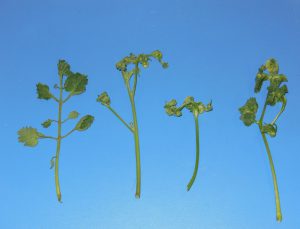
Herbicide damaged tomato plants. Photo by: Mark Tancig
Photos of the tomato plants were shared with other NW District agents and an agriculture agent with livestock and hay producer experience had the probable answer – herbicide damage due to the horses being fed hay from a hayfield that was treated with a particular herbicide. Interestingly, this agent also had experience with these symptoms after their neighbor had similar issues using manure to fertilize the garden.
Herbicides with the active ingredients picloram or aminopyralid are able to cause this kind of unexpected damage to many gardeners’ crops. Herbicides containing these active ingredients are used in hayfields to control broadleaf weeds. These herbicides are especially effective at controlling hard to manage weeds such as thistle, nightshade, and nettle. They also provide long-lasting weed control. Unfortunately, the persistence of these ingredients extends into the hay, and also persists in the manure and urine of animals who eat hay from treated fields. These ingredients pass through the animal unchanged and remain active as an herbicide. Since many vegetable crops are broadleaf plants, the herbicide’s ingredients cause injury.
So what can a farmer or backyard gardener do to prevent this problem? When purchasing hay for livestock, ask the seller if they know whether the hayfield has been treated with herbicides that contain either picloram or aminopyralid. Most herbicides are known by their common names, rather than their chemical name. If they give you a common name or brand name, the active ingredient can be obtained by contacting your local extension office. If the seller can’t tell you, then, as a precaution, do not use the manure to fertilize broadleaf vegetable crops. The same question should be asked if purchasing hay for mulch as well. Composting the manure or hay does not break down the active ingredient, and may even concentrate it.
While we continue to use animal manures to fertilize our crops as our ancestors did, it’s important to remember that many of the tools and products we use today are much more advanced. These advanced products require that we stay informed of all precautions, use them responsibly, and, in this case, inform end users of any precautions. Remember to always read and follow the label and ask questions. And if a science-based answer is what you’re looking for, your local extension office is a good place to go!
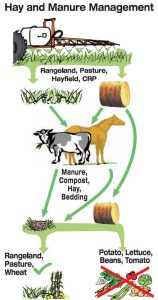
Warning from herbicide label.













